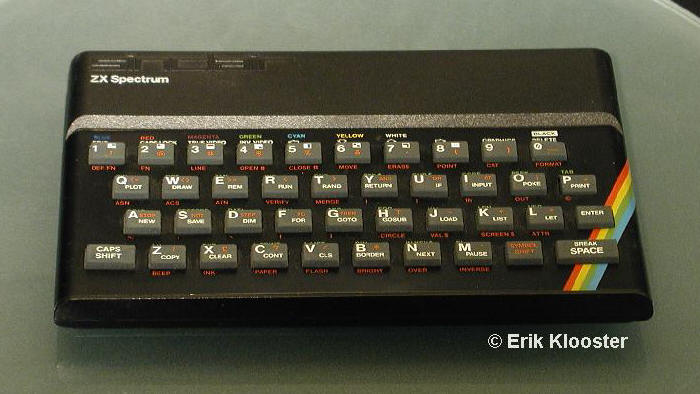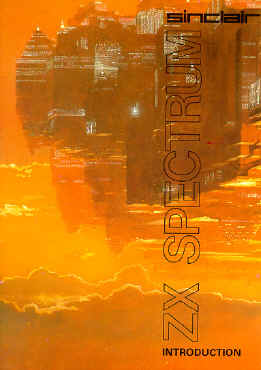
HISTORY OF HOME AND GAME COMPUTERS

| Navigator | ||||||||||||||||||
|
|
|
|
||||||||||||||||
|
|
||||||||||||||||||
|
Court the favours of the BBC
|
Clones
|
Welcome to the nostalgic
history of home and game computers
![]()
SINCLAIR ZX SPECTRUM
the good, old 'speccy'
 After
his modest success with the ZX80 and his already
bigger success with the ZX81, the Britton Clive
Sinclair scored a real hit with the ZX Spectrum. This again small but
surprisingly colourful computer would bring him a fortune and the title of
'Sir' in 1983. He received a knighthood from prime minister Margareth
Thatcher because of his merits to the British industry. After
his modest success with the ZX80 and his already
bigger success with the ZX81, the Britton Clive
Sinclair scored a real hit with the ZX Spectrum. This again small but
surprisingly colourful computer would bring him a fortune and the title of
'Sir' in 1983. He received a knighthood from prime minister Margareth
Thatcher because of his merits to the British industry.Even giant Commodore 64 didn't manage to dispel the ZX Spectrum from the number 1 position in the United Kingdom. Sinclair sold millions of it - the ZX Spectrum became the most successful computer in the UK and one of the most successful computers in the rest of Europe. |
Speccy
Through the ZX81 many people got acquainted with the new world of the
computer, but the Spectrum turned working and playing with computers into
a popular habit. With its greater performances the Spectrum made it
possible for hobbyists to really conquer the new computer world.
Many people still have nostalgic thoughts on the hours (no: days, weeks,
months) they spent in the eighties with their 'Speccy'. And the Speccy is
still popular: there are few other computers for which that many emulators
can be found on the internet.
|
 |
Colours,
finally!
In spite of this there were considerable improvements. That's already
clear when you only take a look at the outside: the little case with
coloured keys and a rainbow-like print looked great. And not only the
outside was colourful - the Spectrum was Sinclair's first computer that
could also put colours on the screen! And this was combined with a
resolution of 256 x 192 pixels. These graphical possibilities were the
biggest improvement, beside the in comparison to the ZX81 enormous
increased RAM. This memory was built-in (soon almost only 48K-Spectrums
were sold), which put an end to the trouble with the wobbling RAM
expansion packs of the ZX80 and ZX81.
Whereas these first computers veiled themselves in silence, the ZX
Spectrum was able to produce sound, albeit very modest. De price was, in
Sinclair's tradition, unmatchable low: 125 British pounds for a
16K-Spectrum and 175 pounds for a model with 48K.
Indeed, the Spectrum could produce colours, but its abilities in this respect were limited. It could display eight colours, but on each square of 8x8 pixels only 2 different colours could be used. This caused the typical Spectrum effect of strange colour combinations, the so-called 'colour-clash'. That's why some game developers only wrote games for the Spectrum in black-and-white.
Many games
It's a question of the chicken and the egg,
but the popularity of the Spectrum was also caused by the enormous amount
of software that was especially written for this home computer. After a
hesitating start, caused by the lack of distribution channels when
Sinclair only sold by mail, many games and other programs were available.
The amount of hardware was also amazing. This time Sinclair manufactured
more hardware options itself, like the Interface 1 and the Interface 2.
With Interface
1 one could connect Sinclair's Microdrive to the Spectrum or shape a
network of Spectrums. Interface 2 made it possible to use joysticks and
contained a port for cartridges. As far as I know there exist about ten
different cartridges (these Sinclair-cartridges were, of course, very
small).
Spectrum+
This
model of the Spectrum was manufactured until 1984. But actually this was
only the beginning: the Spectrum persisted until the early nineties! The
first model was followed by the Spectrum+, the Spectrum 128, the Spectrum
+2 and the Spectrum +3. More about these models soon...
Specifications of the Sinclair ZX Spectrum
| Manufacturer | Sinclair Research |
| Period | 1982 - 1984 |
| CPU | Zilog Z80A |
| Frequency | 3,5 MHz |
| ROM | 16 KB |
| RAM | 16 of 48 KB |
| Text mode | 32 x 24 |
| Graphic mode | 256x192 |
| Colours | 8 |
| Sound | speaker, 1 channel, 5 octaves |
| I/O | tv, cassette, extension port |
| Price | 125 British pounds for the 16 K-model 175 British pounds for the 48 K-model |
| News | |||
|
|
|
|
|
|
|
|||
View results from last poll:
how many games you have? (3127
votes)



